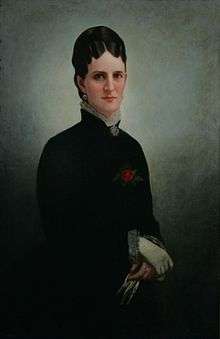Frank Armstrong Crawford Vanderbilt
Frank Armstrong Crawford Vanderbilt (January 18, 1839 – May 4, 1885) was an American socialite and philanthropist. During the American Civil War, she was a strong supporter of the Confederate States of America.[1] After the war, she lived in New York City and married multi-millionaire Cornelius Vanderbilt, who donated $1 million to establish Vanderbilt University in Nashville, Tennessee.
Frank Armstrong Crawford-Vanderbilt | |
|---|---|
 Portrait by William J. Whittemore | |
| Born | Frank Armstrong Crawford January 18, 1839 |
| Died | May 4, 1885 (aged 46) |
| Occupation | Philanthropist |
| Spouse(s) | |
Early life
Frank Armstrong Crawford was born on January 18, 1839 in Mobile, Alabama to Robert Leighton Crawford (1799—1853) and Martha Eliza Everett (1820—1898).[2][3] Her parents named her after their best friend, Frank Armstrong, before she was born, not knowing she would be a girl.[2] Growing up in Mobile, she attended St. Francis Street Methodist Church.[4]
During the American Civil War of 1861—1865, she was "an unrepentant Confederate."[3] After the war, she moved to New York City with her mother.[5][6] Augusta Jane Evans (1835—1909) described her as a "zealous Methodist."[6]
Philanthropy
Crawford persuaded her husband, Cornelius Vanderbilt (1794—1877), to give $1 million to Bishop Holland Nimmons McTyeire (1824—1889), the husband of her cousin, Amelia Townsend (1827—1891), to found Vanderbilt University in Nashville, Tennessee.[3][4][5][7] Cornelius saw this gift as an olive branch to the South, after he had helped defeat the Confederate States Army with his USS Vanderbilt during the Civil War.[3] However, he never visited the university.[3]
Personal life
Crawford was briefly married to John Elliott, but quickly divorced.[8] In 1869, she married Cornelius Vanderbilt after the death of his first wife, Sophia Johnson (1795—1868) (a mutual cousin).[3][6] He was her mother's cousin.[5] She signed a pre-nuptial agreement, agreeing to receive $500,000 in bonds after his death, a great sum at the time but a fraction of Vanderbilt's fortune.[5][9] Confederate General Braxton Bragg and his brother, Confederate Attorney General Thomas Bragg, both attended the wedding.[3]
Death and legacy
She died on May 4, 1885 in Staten Island.[2] Her funeral was conducted by the Rev. Charles Deems in the Church of the Strangers, a church for Southerners in New York that she attended regularly.[3]
Her portrait, painted by William J. Whittemore (1860-1955) in 1906, was donated by her brother Robert Leighton Crawford, Jr. to Vanderbilt University; it is in Kirkland Hall.[2]
Crawford Hall, one of the ten houses on the Martha Rivers Ingram Commons at Vanderbilt University, was named in her honor.[1] An article in the Vanderbilt Political Review about the university's links to slavery notes, "During our research, for example, it was shockingly difficult to find information on Frank Armstrong Crawford’s stance on the Civil War on the Vanderbilt website or in Vanderbilt archives, yet other sources plainly cited her dedication to the Confederate cause."[1]
References
- Bub, Sydney; Mediratta, Avi (October 5, 2016). "The Legacy of Slavery At Vanderbilt". Vanderbilt Political Review. Retrieved August 31, 2017.
- Tennessee Portraits: Frank Armstrong Crawford Vanderbilt
- T.J. Stiles, The Commodore’s Civil War, Vanderbilt Magazine, Spring 2011
- Lyle Lankford, Women to the Rescue, Vanderbilt Magazine, Summer 2009
- Kara Furlong, Commodore's 'strange gift' became educational legacy Archived 2013-10-23 at the Wayback Machine, 03/27/06
- Augusta Jane Evans, A Southern Woman of Letters: The Correspondence of Augusta Jane Evans Wilson, University of South Carolina Press, 2002, p. 153
- Tennessee Portrait Project: Amelia Townsend McTyeire
- Stiles, The First Tycoon, p. 476
- Stiles, The First Tycoon, p. 549